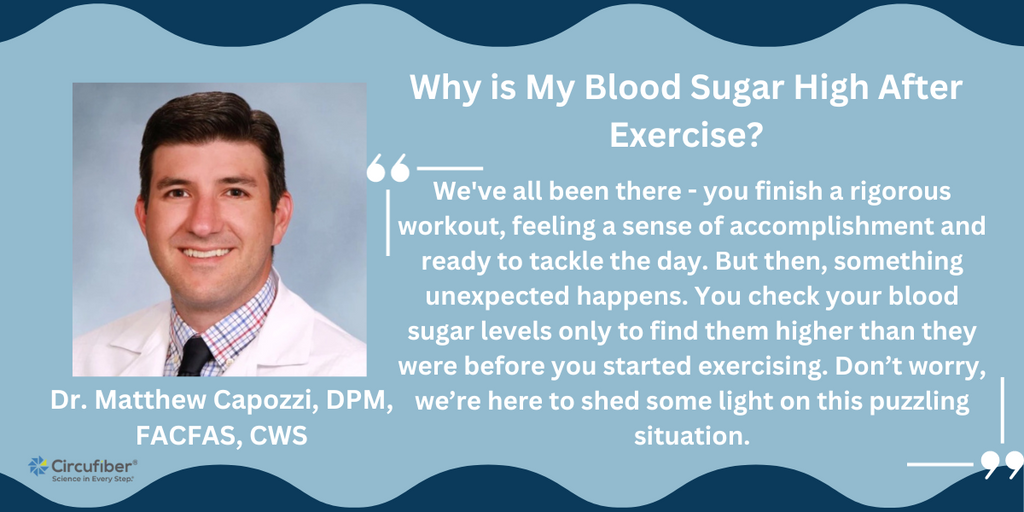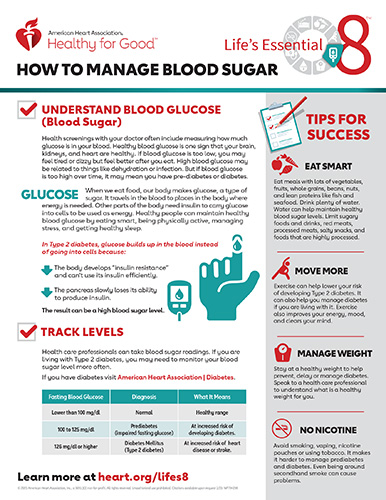We've all been there - you finish a rigorous workout, feeling a sense of accomplishment and ready to tackle the day. But then, something unexpected happens. You check your blood sugar levels only to find them higher than they were before you started exercising. The question arises: why is my blood sugar high after exercise? Don’t worry, we’re here to shed some light on this puzzling situation.

Exercise typically helps lower blood sugar by boosting your sensitivity to insulin. However, in some cases, it can actually increase your levels temporarily due to the body's stress response from intense physical activity. This phenomenon is commonly known as 'exercise-induced hyperglycemia'.
When we do moderate or high-intensity workouts, our bodies release adrenaline (also known as epinephrine) which signals the liver to produce more glucose for energy - thereby potentially causing a temporary spike in blood sugar levels post-exercise. Don't be alarmed though.This is usually a short-term effect and shouldn't undermine the long-term benefits of regular physical activity for managing diabetes and overall health.
Understanding Blood Sugar and Exercise
We're diving into the intricacies of blood sugar levels and exercise, a topic that might leave many scratching their heads. Let's unravel this mystery together.
Blood sugar, also known as glucose, is our body's primary source of energy. When we eat, our bodies break down food into glucose and other nutrients. These are then absorbed into the bloodstream and transported to cells throughout the body. Insulin, a hormone produced in the pancreas, helps our cells to take in glucose.
So you may be wondering - why does my blood sugar shoot up after working out? It's counterintuitive since one would expect physical activity to lower glucose levels instead. After all, exercise encourages our muscles to use more glucose for energy.
Here's where it gets interesting: Not all exercises affect your blood sugar levels in the same way. Yes, aerobic exercises like running or cycling typically lower blood sugar by making your body more sensitive to insulin. But what about high-intensity workouts or weight lifting? These can actually cause a temporary increase in blood sugar levels.
Why does this happen? During intense exercise sessions, our bodies require more energy than usual. To meet this demand, hormones like adrenaline are released which signal the liver to produce extra glucose. This process could result in a temporary spike in your blood sugars.
It's important we mention that these spikes are usually short-lived – once you cool down post-workout and your hormone levels return to normalcy again - so will your sugars.
However sometimes things don't go as smoothly; especially if you have diabetes or insulin resistance - conditions that impair your body’s ability to properly utilize insulin. In such cases high post-workout sugars could be an indication of inadequate insulin functioning rather than just hormonal fluctuations.
Reasons Behind High Blood Sugar After Exercise
Ever wondered why your blood sugar could spike after a good workout? It's counterintuitive, right? You'd expect it to drop. Well, here are some key reasons.
First up, there's something known as the 'hormone surge.' When we exercise, our bodies release stress hormones like adrenaline which help us power through. But these hormones can also trigger your liver to dump extra glucose (sugar) into your bloodstream. So instead of dipping down, your blood sugar levels might actually go up.
Another factor is the type and duration of exercise you're engaged in. Generally speaking, light aerobic exercises like brisk walking or cycling cause blood sugar to drop during and after the activity. However, intense workouts such as weightlifting or sprinting can have the opposite effect - causing a temporary rise in blood sugar.
The timing of meals around exercise is crucial too. Working out on an empty stomach or not eating enough carbs before exercising may lead to higher than usual post-workout blood sugars.
Lastly, let's not forget about hydration – it plays quite a significant role here too. Dehydration may make it harder for insulin (the hormone that regulates blood sugar) to do its job effectively leading to increased glucose levels.
Impact of High Intensity Workouts on Blood Sugar Levels
High intensity workouts can be a double-edged sword when it comes to managing blood sugar levels. On one hand, we know exercise is key in maintaining overall health and regulating glucose levels over the long term. However, it's often surprising to discover that intense physical activity can actually cause a temporary spike in blood sugar.
Let's dive into the science behind this phenomenon. During exercise, our muscles require more energy than usual. To provide this energy, our bodies release stress hormones such as adrenaline and cortisol which stimulate the liver to produce more glucose – hence the potential for higher blood sugar post-workout.
It's important to note that these increases are generally short-lived and not necessarily dangerous if you're otherwise healthy and managing your diabetes effectively. In fact, regular high-intensity workouts can improve insulin sensitivity over time leading to better overall glucose control.
The impact of high-intensity training on blood sugar levels can vary widely from person to person due to factors like fitness level, duration of exercise, type of diabetes, medication use and timing of meals around workouts:
- Fitness Level: Novices may experience sharper spikes compared with seasoned athletes.
- Duration & Intensity: Longer or more intense sessions may lead to higher rises in blood glucose.
- Type of Diabetes: Those with Type 1 diabetes tend to see more dramatic changes than those with Type 2.
- Medication Use: The effects of certain medications could enhance or diminish these shifts in glucose levels.
- Timing of Meals: Eating close to workout times might influence post-exercise glycemic responses.
While it might seem counterintuitive at first glance, recognizing this relationship between high intensity exercises and temporarily elevated blood sugars is an important aspect of managing diabetes effectively. It allows us all - whether we're newbies hitting the gym for the first time or seasoned athletes - the opportunity for better planning our workouts and nutritional strategies to keep our blood sugar levels in check.

Managing Your Blood Sugar During and After Exercise
We've all heard about the multitude of benefits that regular exercise can bring, especially for those of us managing diabetes. But did you know that sometimes physical activity can cause an unexpected spike in blood sugar levels? Let's dive into why this happens and how to manage it.
When we exercise, our bodies need extra energy in the form of glucose. For most people, their bodies produce insulin to help process this glucose and keep blood sugar levels stable. However, when you're living with diabetes, your body doesn't always produce enough insulin or use it effectively. This can lead to higher blood sugar levels after working out.
It may seem counterintuitive but don't let these occasional spikes discourage you from keeping active. Regular physical activity is still a crucial part of managing diabetes. The key lies in understanding how your body responds to different types of exercises and planning accordingly.
Here are some tips we've found helpful:
- Monitor your blood sugar: Before starting an exercise regimen, it's important to know where your blood sugar stands. Try testing before and after workouts until you understand how your body reacts.
- Consider the type of workout: Different exercises have varied impacts on our blood sugars. Activities like weight lifting can actually raise your levels while cardio workouts tend to lower them.
- Stay hydrated: Dehydration affects our ability to regulate blood sugars efficiently so make sure to drink plenty of water during workouts.
- Don’t forget nutrition: Have a small snack before hitting the gym if your pre-workout glucose level is below 100 mg/dL. Likewise, having a protein-rich meal post-exercise helps stabilize sugars.
Remember these are only guidelines; everyone’s body responds differently. It’s about finding what works best for YOU in achieving balanced glucose levels while staying healthy and fit.
Conclusion: Maintaining Balanced Blood Sugar While Exercising
Let's wrap up our discussion on why blood sugar may rise after exercise. It’s crucial to remember that each person's body responds differently to physical activity, so it's important to monitor your blood glucose levels before, during, and after exercise.
We've learned throughout this article that there are several reasons you might see a spike in your blood sugar post-exercise. These can range from hormones released during high-intensity workouts that temporarily raise blood sugar, to the liver releasing extra glucose into the bloodstream when glycogen stores are depleted.
This doesn't mean we should avoid exercising though. Quite contrary, regular physical activity is a key part of managing diabetes because over time it can help lower your overall blood glucose levels. Remember, consistency is vital when it comes to exercising with diabetes. Regular workouts can improve insulin sensitivity and help control fluctuations in your blood glucose levels.
While these tips aren’t exhaustive, they provide a good starting point for maintaining balanced blood sugars during physical activity. Always work closely with your healthcare provider or diabetes educator as they know best about your unique needs and conditions.
Understanding how our bodies react to different types of exercises and taking proactive steps based on that knowledge will empower us in maintaining healthier lifestyles—even with diabetes. This is not just about controlling our numbers but also enhancing our overall quality of life.
References, Sources, and Studies:
https://diabetes.org/health-wellness/fitness/why-does-exercise-sometimes-raise-blood-sugar
More About Circufiber.com and Healthcare disclaimer:
Always consult your physician before beginning any program. This general information is not intended to diagnose any medical condition or to replace your healthcare professional. If you experience any pain or difficulty, stop and consult your healthcare provider. Circufiber.com socks are clinically proven to improve micro-circulation in feet and lower extremities in people with Diabetes.
More Author Information:
Dr. Capozzi is a board-certified foot surgeon through the American Board of Foot and Ankle Surgery. He is a Diplomate of the American Academy of Wound Management and Fellow of the American College of Foot and Ankle Surgeons. He completed a three-year residency program in Foot and Ankle Reconstructive Surgery at St. Francis Hospital & Medical Center in Hartford, CT in 2010. Dr. Capozzi is a board-certified Wound Specialist® granted by the American Academy of Wound Management. He is also board-certified in Foot Surgery through the American Board of Foot and Ankle Surgery.




